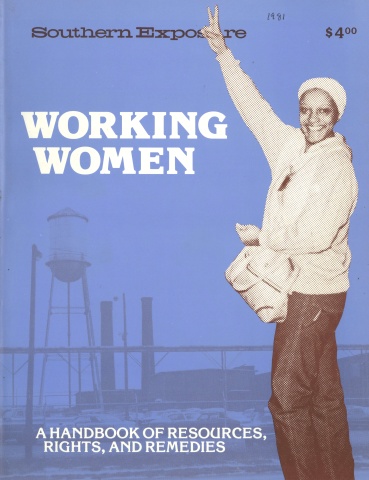The Bottom Line

This article originally appeared in Southern Exposure Vol. 9 No. 4, "Working Women: A Handbook of Resources, Rights, and Remedies." Find more from that issue here.
As the interviews throughout this book reveal, women organize and join unions for many reasons. A union contract forces the employer to write down the rules both sides agree will be used to discipline, or transfer, or fire a worker. A contract protects you against favoritism or arbitrary treatment, it establishes a procedure for handling grievances you may have against your supervisor. It makes the boss respect you and your work more, it gives you somebody (a shop steward or union representative) who will stand by you if you need help; it sets down guidelines for improving working conditions, for protecting your health and safety, for filling new job openings, and in some cases, for handling sexual harassment on the job and enforcing affirmative action in promoting women. It also gives you more money.
Money is the reason most nonunion people think workers get involved with unions; however, union workers say it’s one of the least important gains, ranking better pay and benefits below job security, a grievance procedure, seniority rights, improved respect, personal dignity and other intangibles like “it makes me feel like I can stand up to my boss as an equal.” But the better pay is certainly welcome, and unions work hard to make sure their members earn more than workers not protected by a union contract. From the numbers the government collects, it looks as though they are succeeding.
In 1977, the last year for which such information is available, women represented by labor organizations in the South earned from 19 to 34 percent more than their unrepresented sisters. In terms of hard cash, this means that union women in the East South Central states (see map) earned $ 1,456 more than women doing the same work, perhaps even in the same city, in nonunionized plants. The salary difference in the West South Central region leaped to $2,600, and was slightly higher again for union women in the South Atlantic states: $2,652.
There are no recent studies comparing the financial rewards of union membership for black and white women workers in the South, but a 1974 study published in the Bureau of Labor Statistics’ Monthly Labor Review (Table 1) shows that all classes of workers —black, white, male and female — gained from union representation. Black men in the South benefited the most, earning 30 to 50 percent more, while black women earned 17 to 24 percent more than nonunion workers of the same race and sex; white men gained 15 to 19 percent, with white women slightly higher at 16 to 20 percent.
One of the most dramatic examples of the benefits of union representation is found among clerical workers in Atlanta. Southern Bell Telephone’s clerical workers are represented by the Communications Workers of America (CWA), and they earn from $7.57 to $9.39 an hour after 48 months on the job. Their counterparts in Atlanta’s nonunionized firms bring home $4.18 to $6.67 per hour — 81 percent less than CWA members. Ma Bell’s operators earn a tidy $8.92 after 48 months while switchboard operators — without a union - in Atlanta earn between $4.47 and $4.77, or barely half as much.
The paycheck benefits of a union contract appear in every industry. More than 100,000 Southern women work in plants that produce men’s and boys’ shirts, trousers, suits and coats, an industry in which four out of five of the workers are women. Union workers in suit and coat plants get an average of $ 1.17 for every dollar earned by their nonunion counterparts in the same jobs. Those engaged in the production of trousers make about 10 percent more. And union employees in Southern shirt factories bring home checks that are 13 to 16 percent fatter than those of nonunion shirt makers.
The financial benefits a union provides its members go beyond take-home pay. For example, parking lot attendants at the Atlanta airport — almost all women — are represented by the Service Employees International Union (SEIU). They make 12 percent more than unorganized attendants, plus they have health insurance, eight paid holidays a year and paid sick leave. Women workers at a SEIU-covered nursing home in the mountains of North Carolina also have higher wages than their nonunionized sisters, as well as a system of automatic raises that keeps even the lowest paid worker above the federal minimum wage, a retirement plan, and a health insurance program fully paid for by the employer. With each additional year of employment, an employee can also get the nursing home to pay an increased portion of health insurance coverage for other family members. After 10 years, the company pays the full amount — over $50 a month — a hefty sum for the woman who heads a household or who is married to a man without health insurance.
Money isn’t everything, but a little extra sure helps.
Tags
Debby Warren
Debby Warren is a former editor of a rural weekly newspaper in North Carolina and a former staff member of Women in the Work Force. She now works as a labor planner and researcher. (1981)